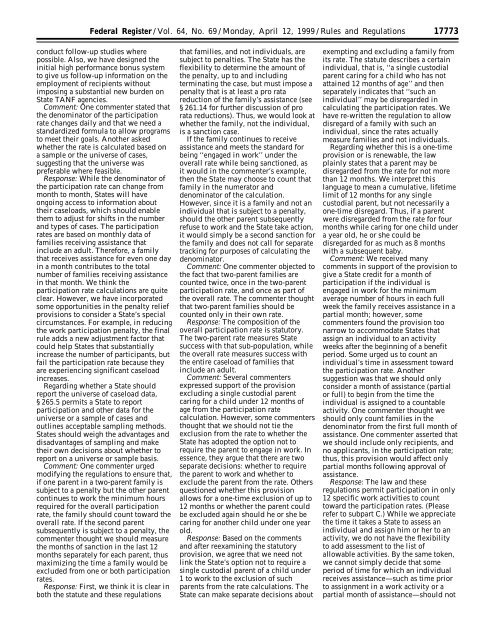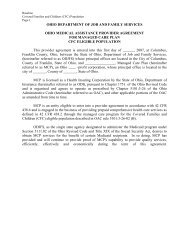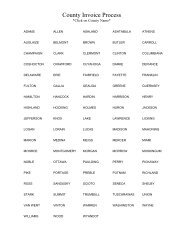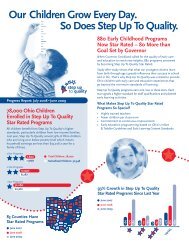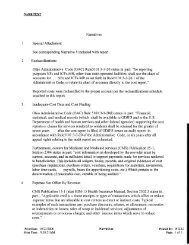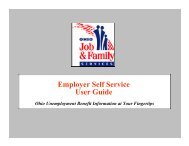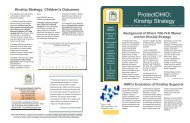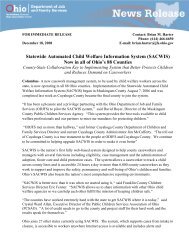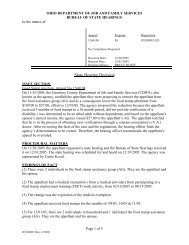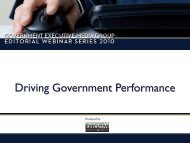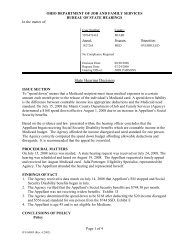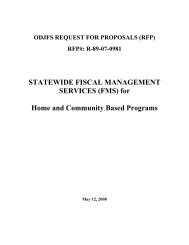Final TANF Rule as published in the Federal Register 4/12/1999
Final TANF Rule as published in the Federal Register 4/12/1999
Final TANF Rule as published in the Federal Register 4/12/1999
You also want an ePaper? Increase the reach of your titles
YUMPU automatically turns print PDFs into web optimized ePapers that Google loves.
<strong>Federal</strong> <strong>Register</strong> / Vol. 64, No. 69 / Monday, April <strong>12</strong>, <strong>1999</strong> / <strong>Rule</strong>s and Regulations<br />
conduct follow-up studies where<br />
possible. Also, we have designed <strong>the</strong><br />
<strong>in</strong>itial high performance bonus system<br />
to give us follow-up <strong>in</strong>formation on <strong>the</strong><br />
employment of recipients without<br />
impos<strong>in</strong>g a substantial new burden on<br />
State <strong>TANF</strong> agencies.<br />
Comment: One commenter stated that<br />
<strong>the</strong> denom<strong>in</strong>ator of <strong>the</strong> participation<br />
rate changes daily and that we need a<br />
standardized formula to allow programs<br />
to meet <strong>the</strong>ir goals. Ano<strong>the</strong>r <strong>as</strong>ked<br />
whe<strong>the</strong>r <strong>the</strong> rate is calculated b<strong>as</strong>ed on<br />
a sample or <strong>the</strong> universe of c<strong>as</strong>es,<br />
suggest<strong>in</strong>g that <strong>the</strong> universe w<strong>as</strong><br />
preferable where fe<strong>as</strong>ible.<br />
Response: While <strong>the</strong> denom<strong>in</strong>ator of<br />
<strong>the</strong> participation rate can change from<br />
month to month, States will have<br />
ongo<strong>in</strong>g access to <strong>in</strong>formation about<br />
<strong>the</strong>ir c<strong>as</strong>eloads, which should enable<br />
<strong>the</strong>m to adjust for shifts <strong>in</strong> <strong>the</strong> number<br />
and types of c<strong>as</strong>es. The participation<br />
rates are b<strong>as</strong>ed on monthly data of<br />
families receiv<strong>in</strong>g <strong>as</strong>sistance that<br />
<strong>in</strong>clude an adult. Therefore, a family<br />
that receives <strong>as</strong>sistance for even one day<br />
<strong>in</strong> a month contributes to <strong>the</strong> total<br />
number of families receiv<strong>in</strong>g <strong>as</strong>sistance<br />
<strong>in</strong> that month. We th<strong>in</strong>k <strong>the</strong><br />
participation rate calculations are quite<br />
clear. However, we have <strong>in</strong>corporated<br />
some opportunities <strong>in</strong> <strong>the</strong> penalty relief<br />
provisions to consider a State’s special<br />
circumstances. For example, <strong>in</strong> reduc<strong>in</strong>g<br />
<strong>the</strong> work participation penalty, <strong>the</strong> f<strong>in</strong>al<br />
rule adds a new adjustment factor that<br />
could help States that substantially<br />
<strong>in</strong>cre<strong>as</strong>e <strong>the</strong> number of participants, but<br />
fail <strong>the</strong> participation rate because <strong>the</strong>y<br />
are experienc<strong>in</strong>g significant c<strong>as</strong>eload<br />
<strong>in</strong>cre<strong>as</strong>es.<br />
Regard<strong>in</strong>g whe<strong>the</strong>r a State should<br />
report <strong>the</strong> universe of c<strong>as</strong>eload data,<br />
§ 265.5 permits a State to report<br />
participation and o<strong>the</strong>r data for <strong>the</strong><br />
universe or a sample of c<strong>as</strong>es and<br />
outl<strong>in</strong>es acceptable sampl<strong>in</strong>g methods.<br />
States should weigh <strong>the</strong> advantages and<br />
disadvantages of sampl<strong>in</strong>g and make<br />
<strong>the</strong>ir own decisions about whe<strong>the</strong>r to<br />
report on a universe or sample b<strong>as</strong>is.<br />
Comment: One commenter urged<br />
modify<strong>in</strong>g <strong>the</strong> regulations to ensure that,<br />
if one parent <strong>in</strong> a two-parent family is<br />
subject to a penalty but <strong>the</strong> o<strong>the</strong>r parent<br />
cont<strong>in</strong>ues to work <strong>the</strong> m<strong>in</strong>imum hours<br />
required for <strong>the</strong> overall participation<br />
rate, <strong>the</strong> family should count toward <strong>the</strong><br />
overall rate. If <strong>the</strong> second parent<br />
subsequently is subject to a penalty, <strong>the</strong><br />
commenter thought we should me<strong>as</strong>ure<br />
<strong>the</strong> months of sanction <strong>in</strong> <strong>the</strong> l<strong>as</strong>t <strong>12</strong><br />
months separately for each parent, thus<br />
maximiz<strong>in</strong>g <strong>the</strong> time a family would be<br />
excluded from one or both participation<br />
rates.<br />
Response: First, we th<strong>in</strong>k it is clear <strong>in</strong><br />
both <strong>the</strong> statute and <strong>the</strong>se regulations<br />
that families, and not <strong>in</strong>dividuals, are<br />
subject to penalties. The State h<strong>as</strong> <strong>the</strong><br />
flexibility to determ<strong>in</strong>e <strong>the</strong> amount of<br />
<strong>the</strong> penalty, up to and <strong>in</strong>clud<strong>in</strong>g<br />
term<strong>in</strong>at<strong>in</strong>g <strong>the</strong> c<strong>as</strong>e, but must impose a<br />
penalty that is at le<strong>as</strong>t a pro rata<br />
reduction of <strong>the</strong> family’s <strong>as</strong>sistance (see<br />
§ 261.14 for fur<strong>the</strong>r discussion of pro<br />
rata reductions). Thus, we would look at<br />
whe<strong>the</strong>r <strong>the</strong> family, not <strong>the</strong> <strong>in</strong>dividual,<br />
is a sanction c<strong>as</strong>e.<br />
If <strong>the</strong> family cont<strong>in</strong>ues to receive<br />
<strong>as</strong>sistance and meets <strong>the</strong> standard for<br />
be<strong>in</strong>g ‘‘engaged <strong>in</strong> work’’ under <strong>the</strong><br />
overall rate while be<strong>in</strong>g sanctioned, <strong>as</strong><br />
it would <strong>in</strong> <strong>the</strong> commenter’s example,<br />
<strong>the</strong>n <strong>the</strong> State may choose to count that<br />
family <strong>in</strong> <strong>the</strong> numerator and<br />
denom<strong>in</strong>ator of <strong>the</strong> calculation.<br />
However, s<strong>in</strong>ce it is a family and not an<br />
<strong>in</strong>dividual that is subject to a penalty,<br />
should <strong>the</strong> o<strong>the</strong>r parent subsequently<br />
refuse to work and <strong>the</strong> State take action,<br />
it would simply be a second sanction for<br />
<strong>the</strong> family and does not call for separate<br />
track<strong>in</strong>g for purposes of calculat<strong>in</strong>g <strong>the</strong><br />
denom<strong>in</strong>ator.<br />
Comment: One commenter objected to<br />
<strong>the</strong> fact that two-parent families are<br />
counted twice, once <strong>in</strong> <strong>the</strong> two-parent<br />
participation rate, and once <strong>as</strong> part of<br />
<strong>the</strong> overall rate. The commenter thought<br />
that two-parent families should be<br />
counted only <strong>in</strong> <strong>the</strong>ir own rate.<br />
Response: The composition of <strong>the</strong><br />
overall participation rate is statutory.<br />
The two-parent rate me<strong>as</strong>ures State<br />
success with that sub-population, while<br />
<strong>the</strong> overall rate me<strong>as</strong>ures success with<br />
<strong>the</strong> entire c<strong>as</strong>eload of families that<br />
<strong>in</strong>clude an adult.<br />
Comment: Several commenters<br />
expressed support of <strong>the</strong> provision<br />
exclud<strong>in</strong>g a s<strong>in</strong>gle custodial parent<br />
car<strong>in</strong>g for a child under <strong>12</strong> months of<br />
age from <strong>the</strong> participation rate<br />
calculation. However, some commenters<br />
thought that we should not tie <strong>the</strong><br />
exclusion from <strong>the</strong> rate to whe<strong>the</strong>r <strong>the</strong><br />
State h<strong>as</strong> adopted <strong>the</strong> option not to<br />
require <strong>the</strong> parent to engage <strong>in</strong> work. In<br />
essence, <strong>the</strong>y argue that <strong>the</strong>re are two<br />
separate decisions: whe<strong>the</strong>r to require<br />
<strong>the</strong> parent to work and whe<strong>the</strong>r to<br />
exclude <strong>the</strong> parent from <strong>the</strong> rate. O<strong>the</strong>rs<br />
questioned whe<strong>the</strong>r this provision<br />
allows for a one-time exclusion of up to<br />
<strong>12</strong> months or whe<strong>the</strong>r <strong>the</strong> parent could<br />
be excluded aga<strong>in</strong> should he or she be<br />
car<strong>in</strong>g for ano<strong>the</strong>r child under one year<br />
old.<br />
Response: B<strong>as</strong>ed on <strong>the</strong> comments<br />
and after reexam<strong>in</strong><strong>in</strong>g <strong>the</strong> statutory<br />
provision, we agree that we need not<br />
l<strong>in</strong>k <strong>the</strong> State’s option not to require a<br />
s<strong>in</strong>gle custodial parent of a child under<br />
1 to work to <strong>the</strong> exclusion of such<br />
parents from <strong>the</strong> rate calculations. The<br />
State can make separate decisions about<br />
17773<br />
exempt<strong>in</strong>g and exclud<strong>in</strong>g a family from<br />
its rate. The statute describes a certa<strong>in</strong><br />
<strong>in</strong>dividual, that is, ‘‘a s<strong>in</strong>gle custodial<br />
parent car<strong>in</strong>g for a child who h<strong>as</strong> not<br />
atta<strong>in</strong>ed <strong>12</strong> months of age’’ and <strong>the</strong>n<br />
separately <strong>in</strong>dicates that ‘‘such an<br />
<strong>in</strong>dividual’’ may be disregarded <strong>in</strong><br />
calculat<strong>in</strong>g <strong>the</strong> participation rates. We<br />
have re-written <strong>the</strong> regulation to allow<br />
disregard of a family with such an<br />
<strong>in</strong>dividual, s<strong>in</strong>ce <strong>the</strong> rates actually<br />
me<strong>as</strong>ure families and not <strong>in</strong>dividuals.<br />
Regard<strong>in</strong>g whe<strong>the</strong>r this is a one-time<br />
provision or is renewable, <strong>the</strong> law<br />
pla<strong>in</strong>ly states that a parent may be<br />
disregarded from <strong>the</strong> rate for not more<br />
than <strong>12</strong> months. We <strong>in</strong>terpret this<br />
language to mean a cumulative, lifetime<br />
limit of <strong>12</strong> months for any s<strong>in</strong>gle<br />
custodial parent, but not necessarily a<br />
one-time disregard. Thus, if a parent<br />
were disregarded from <strong>the</strong> rate for four<br />
months while car<strong>in</strong>g for one child under<br />
a year old, he or she could be<br />
disregarded for <strong>as</strong> much <strong>as</strong> 8 months<br />
with a subsequent baby.<br />
Comment: We received many<br />
comments <strong>in</strong> support of <strong>the</strong> provision to<br />
give a State credit for a month of<br />
participation if <strong>the</strong> <strong>in</strong>dividual is<br />
engaged <strong>in</strong> work for <strong>the</strong> m<strong>in</strong>imum<br />
average number of hours <strong>in</strong> each full<br />
week <strong>the</strong> family receives <strong>as</strong>sistance <strong>in</strong> a<br />
partial month; however, some<br />
commenters found <strong>the</strong> provision too<br />
narrow to accommodate States that<br />
<strong>as</strong>sign an <strong>in</strong>dividual to an activity<br />
weeks after <strong>the</strong> beg<strong>in</strong>n<strong>in</strong>g of a benefit<br />
period. Some urged us to count an<br />
<strong>in</strong>dividual’s time <strong>in</strong> <strong>as</strong>sessment toward<br />
<strong>the</strong> participation rate. Ano<strong>the</strong>r<br />
suggestion w<strong>as</strong> that we should only<br />
consider a month of <strong>as</strong>sistance (partial<br />
or full) to beg<strong>in</strong> from <strong>the</strong> time <strong>the</strong><br />
<strong>in</strong>dividual is <strong>as</strong>signed to a countable<br />
activity. One commenter thought we<br />
should only count families <strong>in</strong> <strong>the</strong><br />
denom<strong>in</strong>ator from <strong>the</strong> first full month of<br />
<strong>as</strong>sistance. One commenter <strong>as</strong>serted that<br />
we should <strong>in</strong>clude only recipients, and<br />
no applicants, <strong>in</strong> <strong>the</strong> participation rate;<br />
thus, this provision would affect only<br />
partial months follow<strong>in</strong>g approval of<br />
<strong>as</strong>sistance.<br />
Response: The law and <strong>the</strong>se<br />
regulations permit participation <strong>in</strong> only<br />
<strong>12</strong> specific work activities to count<br />
toward <strong>the</strong> participation rates. (Ple<strong>as</strong>e<br />
refer to subpart C.) While we appreciate<br />
<strong>the</strong> time it takes a State to <strong>as</strong>sess an<br />
<strong>in</strong>dividual and <strong>as</strong>sign him or her to an<br />
activity, we do not have <strong>the</strong> flexibility<br />
to add <strong>as</strong>sessment to <strong>the</strong> list of<br />
allowable activities. By <strong>the</strong> same token,<br />
we cannot simply decide that some<br />
period of time for which an <strong>in</strong>dividual<br />
receives <strong>as</strong>sistance—such <strong>as</strong> time prior<br />
to <strong>as</strong>signment <strong>in</strong> a work activity or a<br />
partial month of <strong>as</strong>sistance—should not


